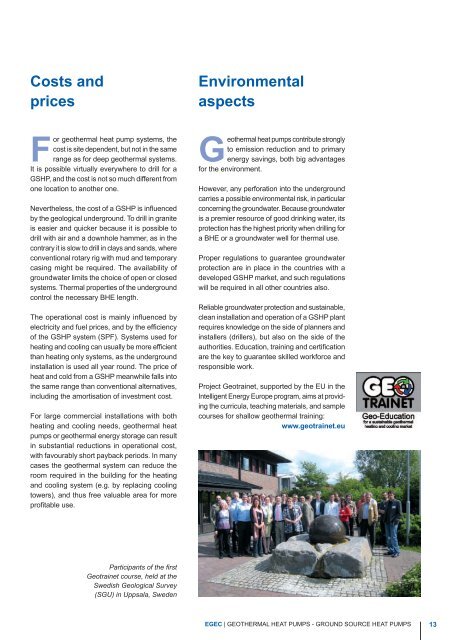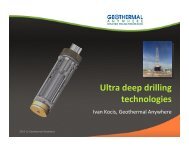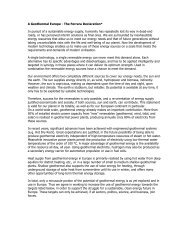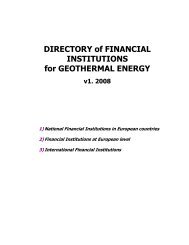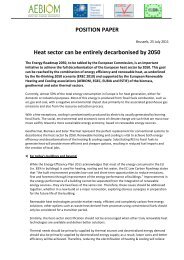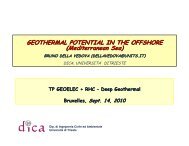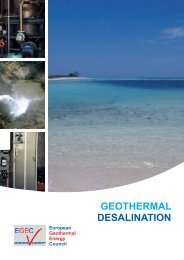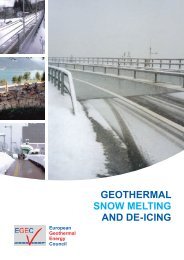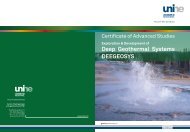GEOTHERMAL HEAT PUMPS - GROUnd SOURCE HEAT ... - EGEC
GEOTHERMAL HEAT PUMPS - GROUnd SOURCE HEAT ... - EGEC
GEOTHERMAL HEAT PUMPS - GROUnd SOURCE HEAT ... - EGEC
You also want an ePaper? Increase the reach of your titles
YUMPU automatically turns print PDFs into web optimized ePapers that Google loves.
Costs and<br />
prices<br />
Environmental<br />
aspects<br />
For geothermal heat pump systems, the<br />
cost is site dependent, but not in the same<br />
range as for deep geothermal systems.<br />
It is possible virtually everywhere to drill for a<br />
GSHP, and the cost is not so much different from<br />
one location to another one.<br />
Nevertheless, the cost of a GSHP is influenced<br />
by the geological underground. To drill in granite<br />
is easier and quicker because it is possible to<br />
drill with air and a downhole hammer, as in the<br />
contrary it is slow to drill in clays and sands, where<br />
conventional rotary rig with mud and temporary<br />
casing might be required. The availability of<br />
groundwater limits the choice of open or closed<br />
systems. Thermal properties of the underground<br />
control the necessary BHE length.<br />
The operational cost is mainly influenced by<br />
electricity and fuel prices, and by the efficiency<br />
of the GSHP system (SPF). Systems used for<br />
heating and cooling can usually be more efficient<br />
than heating only systems, as the underground<br />
installation is used all year round. The price of<br />
heat and cold from a GSHP meanwhile falls into<br />
the same range than conventional alternatives,<br />
including the amortisation of investment cost.<br />
For large commercial installations with both<br />
heating and cooling needs, geothermal heat<br />
pumps or geothermal energy storage can result<br />
in substantial reductions in operational cost,<br />
with favourably short payback periods. In many<br />
cases the geothermal system can reduce the<br />
room required in the building for the heating<br />
and cooling system (e.g. by replacing cooling<br />
towers), and thus free valuable area for more<br />
profitable use.<br />
Geothermal heat pumps contribute strongly<br />
to emission reduction and to primary<br />
energy savings, both big advantages<br />
for the environment.<br />
However, any perforation into the underground<br />
carries a possible environmental risk, in particular<br />
concerning the groundwater. Because groundwater<br />
is a premier resource of good drinking water, its<br />
protection has the highest priority when drilling for<br />
a BHE or a groundwater well for thermal use.<br />
Proper regulations to guarantee groundwater<br />
protection are in place in the countries with a<br />
developed GSHP market, and such regulations<br />
will be required in all other countries also.<br />
Reliable groundwater protection and sustainable,<br />
clean installation and operation of a GSHP plant<br />
requires knowledge on the side of planners and<br />
installers (drillers), but also on the side of the<br />
authorities. Education, training and certification<br />
are the key to guarantee skilled workforce and<br />
responsible work.<br />
Project Geotrainet, supported by the EU in the<br />
Intelligent Energy Europe program, aims at providing<br />
the curricula, teaching materials, and sample<br />
courses for shallow geothermal training:<br />
www.geotrainet.eu<br />
Participants of the first<br />
Geotrainet course, held at the<br />
Swedish Geological Survey<br />
(SGU) in Uppsala, Sweden<br />
<strong>EGEC</strong> | <strong>GEOTHERMAL</strong> <strong>HEAT</strong> <strong>PUMPS</strong> - GROUND <strong>SOURCE</strong> <strong>HEAT</strong> <strong>PUMPS</strong> 13


